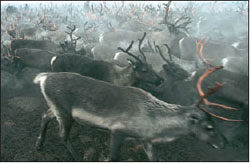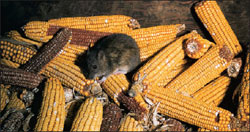Humans and Mammals
 |
| Figure 30-28 Herd of reindeer, Rangifer tarandus, during annual roundup by Laplanders in northern Sweden. The same species is known as caribou in North America. Order Artiodactyla, family Cervidae. |
Humans and Mammals
Some 10,000 years ago, at the time people developed agricultural methods, they also began the domestication of mammals. Dogs were certainly among the first to be domesticated, probably entering voluntarily into their human dependence. The dog is an extremely adaptable and genetically plastic species derived from wolves. Much less genetically variable and certainly less social than dogs is the domestic cat, probably derived from an African race of wildcat. Wildcats look like oversized domestic cats and are still widespread in Africa and Eurasia. Domestication of cattle, buffaloes, sheep, and pigs probably came much later. It is believed the beasts of burden— horses, camels, oxen, and llamas— probably were subdued by early nomadic peoples. Certain domestic species no longer exist as wild animals, for example, the one-humped dromedary camel of North Africa and the llama and alpaca of South America. All truly domestic animals breed in captivity and have become totally dependent on humans; many have been molded by selective breeding to yield characteristics that are desirable for human purposes.
 |
| Figure 30-29 Brown rat, Rattus norvegicus, living all too successfully beside human habitations. Brown rats not only cause great damage to food stores but also spread disease, including bubonic plague (a disease, carried by infected fleas, that greatly influenced human history in medieval Europe), typhus, infectious jaundice, Salmonella food poisoning, and rabies. Order Rodentia, family Muridae. |
Activities of mammals can in some instances conflict with human activities. Rodents and rabbits are capable of inflicting staggering damage to growing crops and stored food (Figure 30-29). We have provided an inviting forage for rodents with our agriculture and convenienced them further by removing their natural predators. Rodents also carry various diseases. Bubonic plague and typhus are carried by various rodents, including house rats and prairie dogs. Tularemia (rabbit fever), is transmitted to humans by the wood tick carried by rabbits, woodchucks, muskrats, and other rodents. Rocky Mountain spotted fever is carried to humans by ticks from ground squirrels and dogs; Lyme disease is transmitted by ticks from white-tailed deer. Trichina worms and tapeworms are acquired by humans who eat the meat of infected hogs, cattle, and other mammals.
In the introduction to this section, we alluded to the discouraging exploitation of whales as one example of our inability to reconcile human needs with preservation of wildlife. Extermination of a species for commercial gain is so totally indefensible that no debate is required. Once a species is extinct, no amount of scientific or technical ingenuity will bring it back. What has taken millions of years to evolve can be destroyed in a decade of thoughtless exploitation. Many people are concerned with the awesome impact we have on wildlife, and there is more determination today to reverse a regrettable trend than ever before. If given a chance, mammals will usually make spectacular recoveries from human depredations, as have the sea otter and the saiga antelope, both once in danger of extinction and now numerous.




